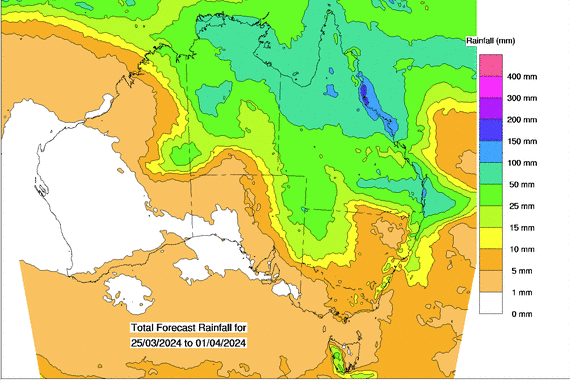Queensland residents are bracing for a wet Easter, with widespread rain predicted for much of the state this weekend.
The tail end of ex-tropical Cyclone Megan dumped significant falls on western parts of the state on Saturday and Sunday, with more rain on the way, according to the Bureau of Meteorology.
Mount Isa received 120 millimetres over the weekend, while Cloncurry recorded 110mm, with similar totals across the region. About 50mm fell in parts of the Blackall-Tambo region.
“Apart from the channel country, the whole of western Queensland has a damp weekend ahead,” meteorologist Livio Regano said.
“Good Friday certainly has showers everywhere and that should continue through the weekend.”
On the coast, a monsoon trough was driving rainfall totals of about 50mm an hour in the Townsville region on Monday morning, the bureau said.
“Everywhere from Ingham to Mackay, including Townsville, are all at risk of further moderate if not heavy falls over the next couple of days,” meteorologist Felim Hanniffy said.
Showers were expected to persist into Easter Sunday for most of the state but totals would be minimal, according to the bureau.
Mr Regano said the remnants of Cyclone Megan were powering the widespread rain.
“Ex-Megan is still a broad low embedded in a trough, sitting in Western Australia,” he said.
“It’s been insidiously hanging around helping channel all this moisture into Queensland like a big conveyor belt.”
Outback residents going ‘stir crazy’
Residents in the state’s gulf region said they were going “stir crazy” as they entered a fourth month of isolation.
Floodwaters surrounded the region, cutting off communities that had been impacted by four cyclones during the 2023-24 wet season.
Doomadgee Aboriginal Shire Council chief executive Troy Fraser said the prolonged isolation was affecting residents’ mental health.
“This is one of the biggest wet seasons I’ve experienced in my life,” he said.
“It could be anywhere between one week to four weeks before we see roads opening up again.
“Residents are frustrated now. They’ve seen enough water. We can’t move around and you can see it’s taking its toll on the community.”
Get our local newsletter, delivered free each Tuesday
